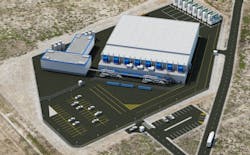How Microgrids and DERs Could Solve the Data Center Power Crisis
Microgrid Knowledge’s annual conference will be held in Dallas, Texas this year. Energy industry leaders and microgrid developers, customers and enthusiasts will gather April 15-17 at the Sheraton Dallas, to learn from each other and discuss a wide variety of microgrid related topics.
There will be sessions exploring the role microgrids can play in healthcare, military, aviation and transportation, as well as other sectors of the economy. Experts will share insights on fuels, creating flexible microgrids, integrating electric vehicle charging stations and more.
“Powering Data Centers: Collaborative Microgrid Solutions for a Growing Market” is expected to be one of the most popular sessions at the conference. Starting at 10:45am on April 16, industry experts will tackle the biggest question facing data center operators and the energy industry – how can we solve the data center energy crisis?
During the session, the panelists will discuss how private entities, developers and utilities can work together to deploy microgrids and distributed energy technologies that address the data center industry’s rapidly growing power needs. They’ll share solutions, technologies and strategies to favorably position data centers in the energy queue.
In advance of the conference, we sat down with two of the featured panelists to learn more about the challenges facing the data center industry and how microgrids can address the sector’s growing energy needs.
We spoke with session chair Samantha Reifer, director of strategic alliances at Scale Microgrids and Elham Akhavan, senior microgrid research analyst at Wood Mackenzie.
Here’s what Reifer and Akhavan had to say:
- The data center industry is growing rapidly. What are the critical challenges facing the sector as it expands?
Samantha Reifer:
The biggest barrier we've been hearing about from our customers and partners is whether these data centers can get power where they want to build? For a colocation center that needs to build closer to city centers, we're starting to see a lack of overall capacity from the utility, both in the electric and the natural gas components needed to power the data centers now and into the next five to 10 years.
What we're seeing from the hyperscaler perspective is that as you start to get farther out from city centers, there’s a lack of infrastructure in addition to power capacity issues. The distribution infrastructure that would allow them to connect to that utility isn’t there.
And then there's also the question of the utility being able to procure and build enough power to support them.
Elham Akhavan: Three critical challenges dominate discussions among the industry: land requirements, electricity, and water needs of new data centers. Developers struggle to find locations that meet all three needs.
Beyond data centers, electricity demand is rising across industries. Manufacturing loads will grow alongside the data center market, especially with U.S. mandates to reshore production. Meeting data center demand also drives power needs for chipmakers, electronics manufacturers, cable suppliers, and racking system producers. Additionally, transportation electrification will further strain the grid.
- How can microgrids and other distributed energy technologies address the challenges facing the data center market?
Akhavan: Microgrids are uniquely positioned to address key data center challenges. Traditionally valued for resilience and reliability, they can now serve as prime power solutions for large loads.
Microgrids can also reduce land requirements. Our cost-per-MW vs. footprint analysis found that fuel cells can deliver around 56 MW per acre, compared to 44 MW for natural gas. While fuel cells have higher Capex, they generate more electricity per acre—an important consideration.
Additionally, CHP and tri-generation systems cut water and cooling costs by using waste heat to support cooling loads. Long seen as a unicorn in distributed energy, microgrids are now gaining even greater value due to data centers' unique demands.
Reifer:
Microgrids are a way of future proofing operations because you're preparing for a lot of unknown scenarios, whether that's the rising costs of power or instability in the grid or the opportunities to generate revenues with your on-site assets.
I think what's really exciting about multi-asset distributed energy solutions and microgrids with solar, batteries and natural gas generators, is that they will help data centers get powered up quickly. Then, as the grid grows and potentially interconnects with these large data center facilities, those resources can become dispatchable assets that service both the customer in terms of utility bill reduction, as well as the utility through things like demand response programs. I think this is something that all utilities should be mindful of today as these customers are deploying tens and potentially hundreds of megawatts of dispatchable assets. How can these assets be utilized to support the grid and the customer?
MGK Featured Speakers
At the Microgrid Knowledge conference, Reifer and Akhavan will be among the featured speakers for the “Powering Data Centers: Collaborative Microgrid Solutions for a Growing Market” session. They will be joined on stage by Nina Sadighi, founder of Eradeh Power Consulting, a power engineering services company, and Michael Carney, senior solutions architect – clean power solutions at Baker Hughes.
You can read Sadighi’s responses to these questions here.
Akhavan will also be chairing a session on April 15 entitled “Monetizing Grid Support.”
About the Author

Kathy Hitchens
Kathy Hitchens has been writing professionally for more than 30 years. She focuses on the renewable energy, electric vehicle, utility, data center, and financial services sectors. Kathy has a BFA from the University of Arizona and a MBA from the University of Denver.


